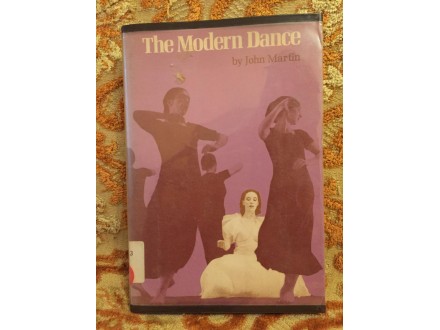John Martin MODERN DANCE
| Cena: |
| Želi ovaj predmet: | 1 |
| Stanje: | Polovan bez oštećenja |
| Garancija: | Ne |
| Isporuka: | BEX Pošta DExpress Post Express Lično preuzimanje |
| Plaćanje: | Tekući račun (pre slanja) Ostalo (pre slanja) Pouzećem Lično |
| Grad: |
Novi Sad, Novi Sad |
Godina izdanja: Ostalo
Oblast: Ostalo
ISBN: Ostalo
Jezik: Engleski
Autor: Strani
Kao na slikama
Savremeni ples
John Martin (June 2, 1893 – May 19, 1985) became America`s first major dance critic in 1927. Focusing his efforts on propelling the modern dance movement, he greatly influenced the careers of dancers such as Martha Graham. Within his life he wrote several books on the modern dance and received numerous awards for his work.
Early life Edit
John Martin`s life leading up to his career may have led him to the success he later attained. Martin was born June 2, 1893 in Louisville, Kentucky and was immediately influenced by his mother`s love of musical theatre.[1] After his education at the Louisville Male High School, he held several jobs as actor, publicist, and editor in Louisville and New York.[2][3] During World War I, he served in the Aviation Section of the Army Signal Corps, after which he returned to theatre working with the Chicago Little Theatre where he met his wife Hettie Louise Mick.[1] They married in 1918. He also served as director and press agent for many different theatre projects.[3] Over the years, Martin developed an interest in the actor/director/drama teacher Konstantin Stanislavsky`s system which expressed the `dramatic impulses that arise within`[4] Many have claimed that Stanislavsky`s ideas influenced Martin`s interest in modern dance because it displays this quality.
Career Edit
As a dance critic, Martin fought many preconceived ideas within the newly created genre of writing to become one of the most influential writers in dance history. Before there were actual designated dance critics, music and theatre critics were reluctantly sent to review ballets.[5] Their writing would rant about the music and the symphony while almost completely disregarding the dancing. Following a series of Ted Shawn and Ruth St. Denis Carnegie Hall performances, petitions began to arise in favor of dance critics in New York news papers. The New York Herald Tribune quickly responded with Mary Watkins and a few weeks later, The New York Times appointed Martin in 1927.[3][6] Martin saw it as his duty to spread `the gospel of the modern dance.`[7] As a dance critic, he and others were convinced they would not become a `subspecies of music criticism` and set out to prove this by educating the audience and the dancers in the ways of professionalism. His efforts brought modern dance to a level equal in stature and independent of music and theatre within the arts.[5]
Because this new dance form was so drastically different from the structured ballet to which people had become accustomed, Martin greatly aided in the development of a vocabulary that suited the developing new modern dance. He pleaded that the audience `lay aside its preconceptions`.[8] This `role of the viewer` and other theories were stressed in his lectures at the New School and Bennington. These lectures were soon formed into books, the first of which, The Modern Dance, was published in 1933.[9] Throughout his articles and books Martin developed his ideas of modern dance. He saw the modern movement as truly American because these dancers were driven by their experience. They were their movement conveyed the concerns that arose from their everyday life.[10] He shared the belief that movement stems from the essence of emotion with many modern dancers of that time. He exalted them for their `expression of an inner compulsion.`[11] He had high expectations of the dancers and their ability to penetrate the minds of the audience. In turn, he expected the audience to widen their perceptions.[12]
Towards the end of his career, Martin began to ignore the new generation of modern dancers who followed in the pioneers` footsteps because they did not focus on the same quality of essence upon which the first generation built the foundation of modern dance.[13] He eventually turned to ballet criticism for which he was chastised by other critics and modern dancers.
After his retirement in 1962, he taught at the University of California, Los Angeles for five years.[2] Towards the end of his life, Zachary Solov, a dancer-choreographer, invited Martin to share a house in Saratoga Springs, New York. Martin lived here until his death May 19, 1985.[1][14]
Influence Edit
Not only did Martin aid in the progress the modern dance, he also advanced the careers of the choreographers. Martha Graham is among the most well known of these dancers who were advanced professionally by Martin`s words. Martin discovered that Graham was the epitome of his theory of modern dance in action. Between 1930 and 1935 there are more articles by Martin on Graham than any other dancer.[15] Perhaps this is because Martin was developing his methodology and used Graham as a focal point for `diagramming and disseminating the form and function of the modern dance.`[15]
Awards and recognition Edit
Martin received several awards and honors including a Capezio Dance Award in 1969, two honorary doctorates from Ohio University in 1974 and Skidmore College in 1982, and an exhibition dedicated to his writings by the Dance Collection of the New York Public Library. Most recently, in December 2012, Martin was named one of America`s Irreplaceable Dance Treasures by the Dance Heritage Coalition, and his contribution to the development of dance criticism and modern dance is commemorated in the Dance Heritage Coalition`s online exhibition of Dance Treasures.
In 1967 he was a Heritage Award recipient of the National Dance Association.
Martin was inducted into the National Museum of Dance`s Mr. & Mrs. Cornelius Vanderbilt Whitney Hall of Fame in 1988.
Moderni ples je široki žanr zapadnog koncertnog ili pozorišnog plesa, prvenstveno nastao u Nemačkoj i Sjedinjenim Državama krajem 19. i početkom 20. veka.
Marta Graham 1948. godine
Isidora Dankan 1903. godine
Plesač u Labanovoj školi, Berlin 1929
Smatra se da se moderni ples pojavio kao odbacivanje ili pobuna protiv klasičnog baleta. Socioekonomski i kulturni faktori takođe su doprineli njegovom razvoju. Krajem 19. veka, plesni umetnici poput Izadore Dankan, Maud Alan i Loje Fuler bili su pioniri novih oblika i praksi u onome što se danas naziva estetskim ili slobodnim plesom za izvođenje. Ovi plesači su zanemarili strog baletski rečnik, određeni, ograničeni skup pokreta koji su se smatrali svojstvenim baletu i prestali su da nose korsete i špic-patike u potrazi za većom slobodom kretanja.
Tokom 20. veka, sociopolitička zabrinutost, glavni istorijski događaji i razvoj drugih umetničkih oblika doprineli su daljem razvoju modernističkog plesa u Sjedinjenim Državama i Nemačkoj. Prelazeći u šezdesete godine, počele su da se pojavljuju nove ideje o plesu, kao odgovor na ranije forme plesa i na društvene promene. Na kraju, postmoderni plesni umetnici odbacili su formalizam modernog plesa i uključili elemente kao što su umetnost performansa, kontaktna improvizacija, tehnika oslobađanja i improvizacija.[1]
Američki moderni ples može se (grubo) podeliti u tri perioda ili ere. Tokom ranog modernog doba (oko 1880–1923), ovaj ples je bio karakterisan radovima Izadore Dankan, Loje Fuler, Rut St. Denis, Teda Šona i Eleanor King, što je radikalno izmenjena umetnička praksa, ali još uvek nisu postojale jasno izražene moderne plesne tehnike. Tokom centralnog modernog perioda (oko 1923–1946), koreografi Marta Graham, Doris Hamfri, Katerin Danham, Čarls Vejdman i Lester Horton nastojali su da razviju prepoznatljivo američke stilove pokreta i rečnika, i razvili su jasno definisane i prepoznatljive sisteme plesnog treninga. U periodu kasne moderne (oko 1946–1957), Hose Limon, Perl Prajmus, Mers Kuningam, Tejli Biti, Erik Hokins, Ana Sokolov, Ana Halprin, Pol Tejlor uveli su jasan apstrakcionizam i avangardne pokrete i otvorili put postmodernom plesu.[2]
Zaleđina Уреди
Smatra se da se moderni ples pojavio kao odbacivanje ili pobuna protiv klasičnog baleta, iako istoričari sugerišu da su socioekonomske promene u Sjedinjenim Državama i Evropi pomogle da se pokrenu promene u svetu plesa. U Americi su sve veća industrijalizacija, uspon srednje klase (koja je imala više raspoloživog dohotka i slobodnog vremena) i oronjavanje viktorijanskih socijalnih ograničenja doveli su, između ostalih promena, do novog interesovanja za zdravlje i fizičku sposobnost.[3] „U toj atmosferi je nastao ’novi ples’ koliko iz odbacivanja društvenih struktura, tako i iz nezadovoljstva baletom.“[4] U tom istom periodu „prvaci fizičkog vaspitanja pomogli su da se pripremi put za savremeni ples i gimnastičke vežbe služile su kao tehnička polazišta mladim ženama koje su želele da plešu.“[5] Ženski koledži su počeli da nude kurseve „estetskog plesa“ krajem 1880-ih.[6] Emil Rat, koji je u to vreme opširno pisao o ovom novom obliku umetnosti, napominje
„Muzika i ritmički telesni pokreti su sestre blizankinje, budući da su istovremeno nastale ... danas u umetničkom delu Isadore Dunkan, Maud Alan i drugih vidimo upotrebu oblika plesa koji nastoji da prikaže u pokretima ono što muzički majstor izražava u svojim kompozicijama - interpretativno plesanje“.[7]
Radikalni ples Уреди
Uznemireni Velikom depresijom i rastućom prijetnjom fašizma u Evropi, radikalni plesači pokušali su uvećaju svesnost dramatizujući ekonomske, socijalne, etničke i političke krize svog vremena.
Hanja Holm, učenica Mari Vigman i instruktor u Vigmanovoj školi u Drezdenu, osnovala je Njujoršku Vigmanovu školu plesa 1931. godine (koja je 1936. postala Studio Hanje Holm) uvodeći Vigmanovu tehniku, Labanove teorije prostorne dinamike, a kasnije i svoje sopstvene plesne tehnike američkog modernog plesa. Kao iskusna koreografkinja, ona je bila osnivač prvog Američkog plesnog festivala u Beningtonu (1934). Plesno delo Holmove pod naslovom Metropolitan Dejli bila je prva moderna plesna kompozicija koja je emitovana na NBC-u, a njen labanotacijska partitura za Kiss Me, Kate (1948) bila je prva koreografija koja je zaštićena autorskim pravima u Sjedinjenim Državama. Holmova je koreografisala u poljima koncertnog plesa i muzičkog pozorišta.[8]
Ana Sokolov - Učenica Marte Graham i Luisa Horsta, Sokolova je stvorila sopstvenu plesnu kompaniju (oko 1930). Prikazujući dramatične savremene slike, kompozicije Sokolove uglavnom su bile apstraktne, često su otkrivale čitav spektar ljudskog iskustva koji odražava napetost i otuđenost vremena i istinutost ljudskog kretanja.
Hose Limon - 1946. godine, nakon studija i nastupa sa Doris Humfri i Čarlsom Vejdmanom. Limon je osnovao sopstvenu kompaniju sa Humfrijem kao umetničkim direktorom. Pod njenim mentorstvom Limon je stvorio svoj autentični ples The Moor’s Pavane (1949). Limonova koreografska dela i tehnika ostaju snažan uticaj na savremenu plesnu praksu.[9]
U Sjedinjenim Državama
Zaostavština mod
Knjiga o modernom plesu
Moderne igre
International shipping
Paypal only
(Države Balkana: Uplata može i preko pošte ili Western Union-a)
1 euro = 117.5 din
For international buyers please see instructions below:
To buy an item: Click on the red button KUPI ODMAH
Količina: 1 / Isporuka: Pošta / Plaćanje: Tekući račun
To confirm the purchase click on the orange button: Potvrdi kupovinu (After that we will send our paypal details)
To message us for more information: Click on the blue button POŠALJI PORUKU
To see overview of all our items: Click on Svi predmeti člana
Ako je aktivirana opcija besplatna dostava, ona se odnosi samo na slanje kao preporučena tiskovina ili cc paket na teritoriji Srbije.
Poštarina za knjige je u proseku 133-200 dinara, u slučaju da izaberete opciju plaćanje pre slanja i slanje preko pošte. Postexpress i kurirske službe su skuplje ali imaju opciju plaćanja pouzećem. Ako nije stavljena opcija da je moguće slanje i nekom drugom kurirskom službom pored postexpressa, slobodno kupite knjigu pa nam u poruci napišite koja kurirska služba vam odgovara.
Ukoliko još uvek nemate bar 10 pozitivnih ocena, zbog nekoliko neprijatnih iskustava, molili bi vas da nam uplatite cenu kupljenog predmeta unapred.
Novi Sad lično preuzimanje (pored Kulturne stanice Eđšeg) ili svaki dan ili jednom nedeljno zavisno od lokacije prodatog predmeta (jedan deo predmeta je u Novom Sadu, drugi u kući van grada).
Našu kompletnu ponudu možete videti preko linka
https://www.kupindo.com/Clan/H.C.E/SpisakPredmeta
Ukoliko tražite još neki naslov koji ne možete da nađete pošaljite nam poruku možda ga imamo u magacinu.
Pogledajte i našu ponudu na limundu https://www.limundo.com/Clan/H.C.E/SpisakAukcija
Slobodno pitajte šta vas zanima preko poruka. Preuzimanje moguce u Novom Sadu i Sremskoj Mitrovici uz prethodni dogovor. (Većina knjiga je u Sremskoj Mitrovici, manji broj u Novom Sadu, tako da se najavite nekoliko dana ranije u slucaju ličnog preuzimanja, da bi knjige bile donete, a ako Vam hitno treba neka knjiga za danas ili sutra, obavezno proverite prvo preko poruke da li je u magacinu da ne bi doslo do neprijatnosti). U krajnjem slučaju mogu biti poslate i poštom u Novi Sad i stižu za jedan dan.
U Novom Sadu lično preuzimanje na Grbavici na našoj adresi ili u okolini po dogovoru. Dostava na kućnu adresu u Novom Sadu putem kurira 350 dinara.
Slanje nakon uplate na račun u Erste banci (ukoliko ne želite da plaćate po preuzimanju). Poštarina za jednu knjigu, zavisno od njene težine (do 2 kg), može biti od 170-264 din. Slanje vise knjiga u paketu težem od 2 kg 340-450 din. Za cene postexpressa ili drugih službi se možete informisati na njihovim sajtovima.
http://www.postexpress.rs/struktura/lat/cenovnik/cenovnik-unutrasnji-saobracaj.asp
INOSTRANSTVO: Šaljem po dogovoru, ili po vašim prijateljima/rodbini ili poštom. U Beč idem jednom godišnje pa ako se podudare termini knjige mogu doneti lično. Skuplje pakete mogu poslati i po nekom autobusu, molim vas ne tražite mi da šaljem autobusima knjige manje vrednosti jer mi odlazak na autobusku stanicu i čekanje prevoza pravi veći problem nego što bi koštala poštarina za slanje kao mali paket preko pošte.
Ukoliko kupujete više od jedne knjige javite se porukom možda Vam mogu dati određeni popust na neke naslove.
Sve knjige su detaljno uslikane, ako Vas još nešto interesuje slobodno pitajte porukom. Reklamacije primamo samo ukoliko nam prvo pošaljete knjigu nazad da vidim u čemu je problem pa nakon toga vraćamo novac. Jednom smo prevareni od strane člana koji nam je vratio potpuno drugu knjigu od one koju smo mu mi poslali, tako da više ne vraćamo novac pre nego što vidimo da li se radi o našoj knjizi.
Ukoliko Vam neka pošiljka ne stigne za dva ili tri dana, odmah nas kontaktirajte za broj pošiljke kako bi videli u čemu je problem. Ne čekajte da prođe više vremena, pogotovo ako ste iz inostranstva, jer nakon određenog vremena pošiljke se vraćaju pošiljaocu, tako da bi morali da platimo troškove povratka i ponovnog slanja. Potvrde o slanju čuvamo do 10 dana. U 99% slučajeva sve prolazi glatko, ali nikad se ne zna.
Ukoliko uvažimo vašu reklamaciju ne snosimo troškove poštarine, osim kada je očigledno naša greška u pitanju.
Predmet: 70221577











